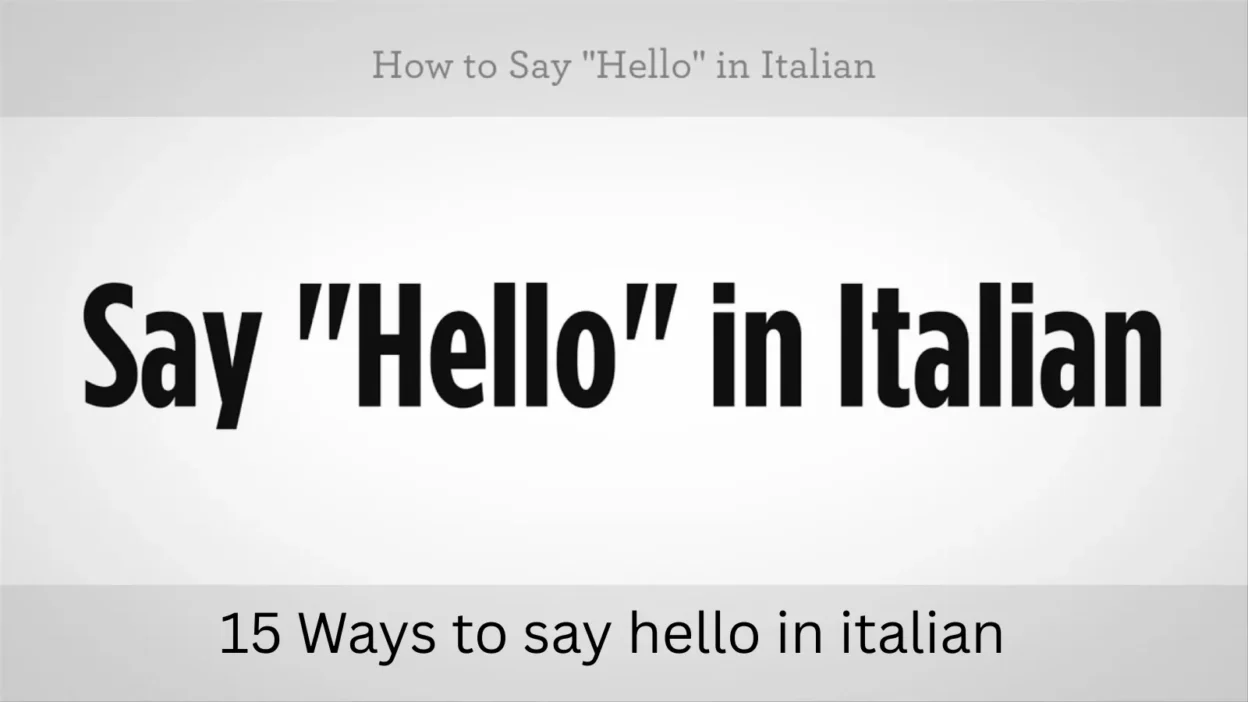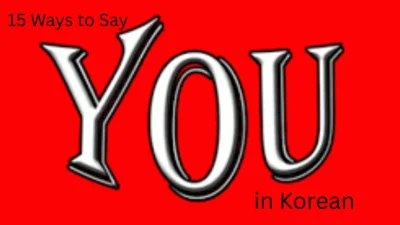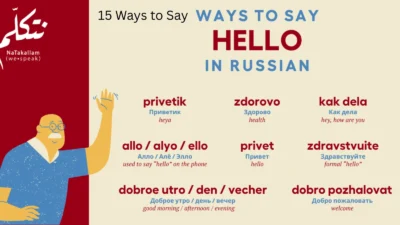How to Say Hello in Italian 🇮🇹 is one of the first and most essential phrases to learn when starting the language. Greetings in italian are an important part of Italian culture, and knowing the right way to say hello will help you make a great first impression.
In this guide, we’ll explore how to say hello/hi in Italian in both formal and casual situations so you can greet people with confidence.
Learning how to say hello in Italian will make your interactions warmer and more genuine. You’ll be able to connect naturally whether you’re traveling in Italy, meeting Italian speakers, or starting a conversation online.
By practicing how to say hello in Italian, you’ll sound more authentic and confident. Whether in business, friendship, or casual chats, how to say hello Italian is a phrase you’ll use daily.
Hello in Italian language Examples & Origin:
🔹 15 Ways to Say Italian Hello
| No. | Italian Phrase | English Meaning | Use / Tone |
|---|---|---|---|
| 1 | Ciao | Hello / Hi | Informal, friends & family |
| 2 | Salve | Hello | Neutral, polite |
| 3 | Buongiorno | Good morning / Hello | Formal, daytime |
| 4 | Buonasera | Good evening / Hello | Formal, evening |
| 5 | Buonanotte (as greeting) | Good night / Hello (rare) | Very casual, nighttime |
| 6 | Pronto (on phone) | Hello (on the phone) | Standard phone greeting |
| 7 | Ehilà | Hey there! | Very informal |
| 8 | Ueilà | Hi! | Slangy, playful |
| 9 | Ciao bella! | Hello beautiful! | Friendly/romantic |
| 10 | Ciao caro! | Hello dear! | Warm, close tone |
| 11 | Ciao ragazzi! | Hello guys! | Group greeting |
| 12 | Buondì | Good day / Hello | Casual, daytime |
| 13 | Bella lì! | Hey, what’s up! | Informal, slang |
| 14 | Ciao amico! | Hello friend! | Casual, warm |
| 15 | Bentornato! | Welcome back! | Greeting after absence |
What is Hello in Italian
🔹 Origin
The word most commonly used for hello in Italian is “Ciao”, which comes from the Venetian phrase s’ciavo vostro, meaning “I am your servant.” Over time, it lost its literal meaning and became a casual, friendly greeting. Italians also use other forms such as salve, buongiorno, and buonasera, depending on the context and level of formality.
🔹 Examples
- Ciao, amico mio! → Hello, my friend!
- Salve, come va? → Hello, how’s it going?
- Buongiorno a tutti. → Hello / Good morning, everyone.
- Buonasera, signore. → Hello / Good evening, sir.
- Ciao bella! → Hello, beautiful!
Italian for Hello
🔹 Origin
The most common Italian greeting “Ciao” actually comes from the Venetian phrase s’ciavo vostro, meaning “I am your servant”—a polite expression of respect in older times. Over the years, it shortened into ciao and became the friendly “hello” we use today.
🔹 Examples
- Ciao! Come va? → Hello! How’s it going?
- Ciao a tutti! → Hello everyone!
- Ciao, amico mio. → Hello, my friend.
- Ciao bella! → Hello, beautiful! (friendly/romantic)
- Ciao ragazzi! → Hello guys!
How do you Say Hello in Italian
1. Ciao
Origin:
From the Venetian word s-ciào, meaning “I am your servant,” it evolved into a casual greeting across Italy. Today, “ciao” means both “hello” and “goodbye.”
Example:
👤 User A: Ciao, Marco! Tutto bene?
👤 User B: Ciao! Sì, tutto a posto. E tu?
Use: Informal; perfect among friends, family, or peers.
How to Say Hello in Italian Informal
🔹 Origin
The most common informal hello in Italian is “Ciao”, a word that comes from the Venetian phrase s’ciavo vostro, meaning “I am your servant.” Today, it’s used casually among friends, family, and peers.
🔹 Examples
- Ciao, come stai? → Hi, how are you?
- Ciao ragazzi! → Hi, guys!
- Ehilà, che fai? → Hey, what are you doing?
- Ueilà, tutto bene? → Hey, all good?
- Ciao bella! → Hi, beautiful!
2. Salve
Origin:
Derived from Latin salvus, meaning “safe” or “healthy,” this greeting dates back to ancient Rome and is still used in modern Italian.
Example:
👤 User A: Salve, signora Bianchi.
👤 User B: Salve! Come posso aiutarla?
Use: Neutral to formal; polite and respectful.
3. Buongiorno (Hello in Italian formal)

Origin:
Means “good day.” A standard Italian greeting used from morning until early afternoon.
Example:
👤 User A: Buongiorno, professore!
👤 User B: Buongiorno, Giulia. Come stai?
Use: Formal or polite, great for daytime encounters.
4. Buonasera
Origin:
Literally means “good evening.” Used after 2 PM or in the early evening hours.
Example:
👤 User A: Buonasera, dottore.
👤 User B: Buonasera! È pronto per l’appuntamento?
Use: Formal; evening settings.
5. Ehilà!
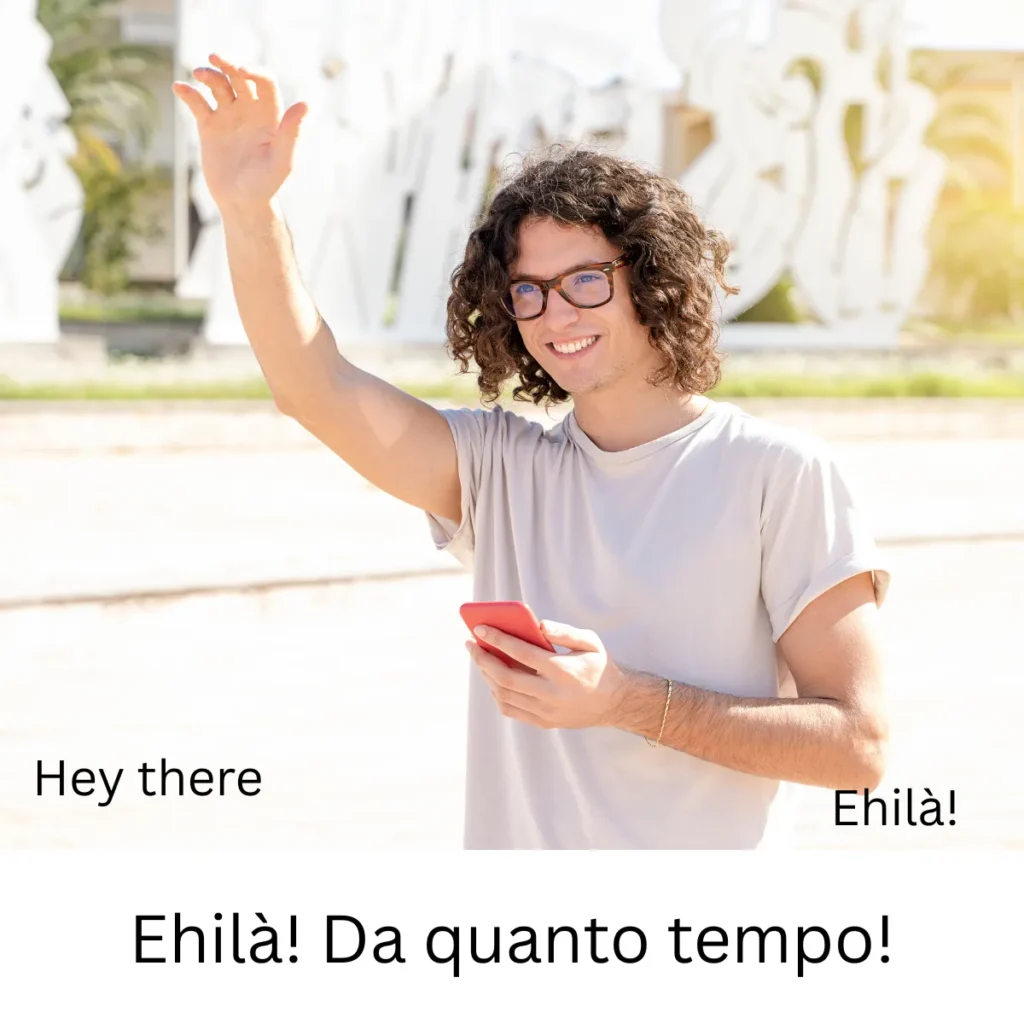
Origin:
An informal attention-getting shout, like saying “Hey there!” in English.
Example:
👤 User A: Ehilà! Da quanto tempo!
👤 User B: Ehilà! È vero, troppo tempo!
Use: Very casual; enthusiastic greeting among close friends.
6. Buon pomeriggio
Origin:
Means “good afternoon,” but it’s less common in casual speech and more typical in formal communication or written form.
Example:
👤 User A: Buon pomeriggio, avvocato Rossi.
👤 User B: Buon pomeriggio! Prego, si accomodi.
Use: Formal; polite but rarely used verbally.
7. Ciao bella / Ciao bello
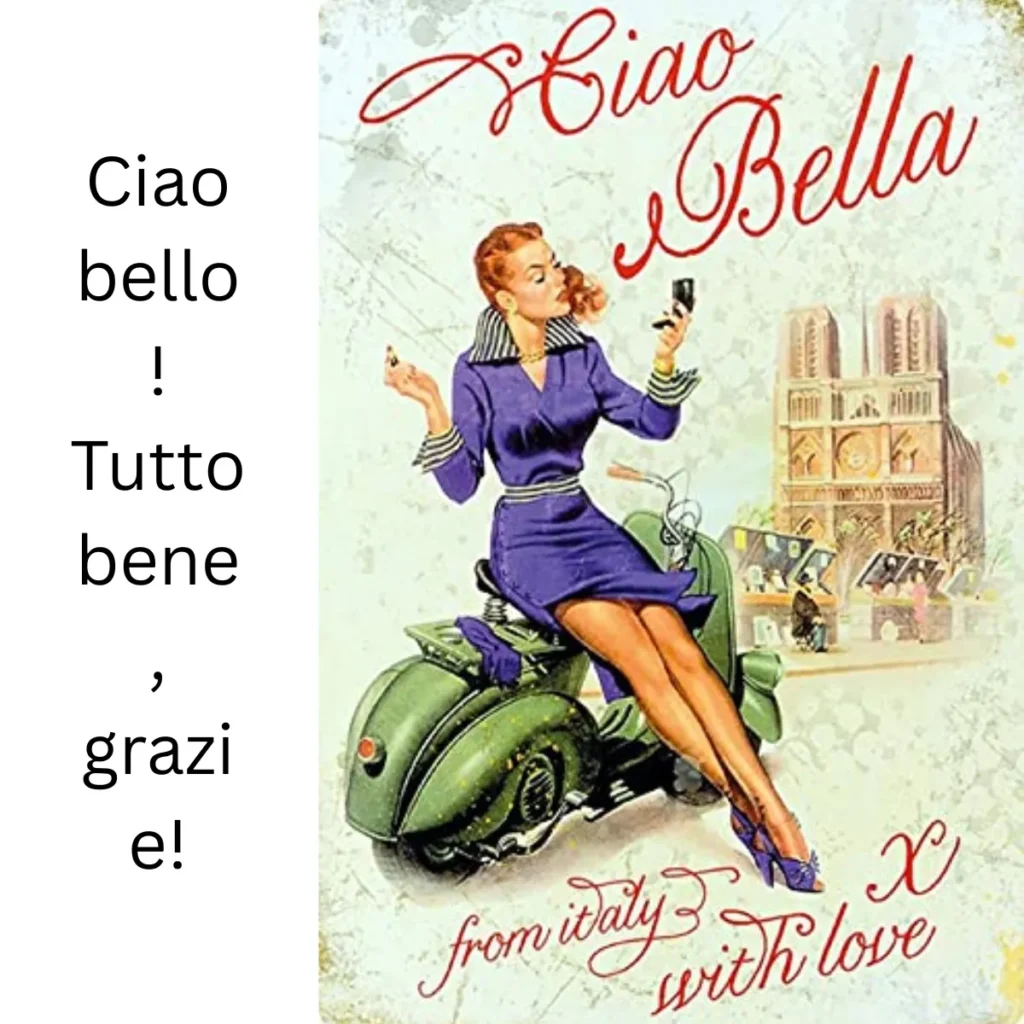
Origin:
Literally “hi beautiful” (feminine/masculine). Often used flirtatiously or affectionately.
Example:
👤 User A: Ciao bella, come va?
👤 User B: Ciao bello! Tutto bene, grazie!
Use: Informal, affectionate, sometimes flirtatious.
8. Pronto?
Origin:
Means “ready?”—but it’s how Italians say “hello” on the telephone.
Example:
📞 User A: Pronto?
📞 User B: Ciao! Sono io.
Use: Only used when answering the phone.
9. Bentornato / Bentornata
Origin:
Means “welcome back” (masculine/feminine). Used when someone returns.
Example:
👤 User A: Bentornata, Maria! Ci sei mancata!
👤 User B: Grazie mille! Felice di essere tornata.
Use: Warm greeting for someone returning after time away.
10. Piacere!
Origin:
Short for “Piacere di conoscerti” (Nice to meet you). Though not a direct “hello,” it’s used when meeting someone new.
Example:
👤 User A: Ciao, sono Luca.
👤 User B: Piacere! Io sono Chiara.
Use: First-time meetings; polite and friendly.
11. Uè
Origin:
Used mainly in Milan and Southern Italy, this informal greeting is similar to “Yo!” or “Hey!”
Example:
👤 User A: Uè, fratello! Tutto a posto?
👤 User B: Uè! Sì, tutto ok!
Use: Informal; regional; often among men.
12. Buongiorno a tutti
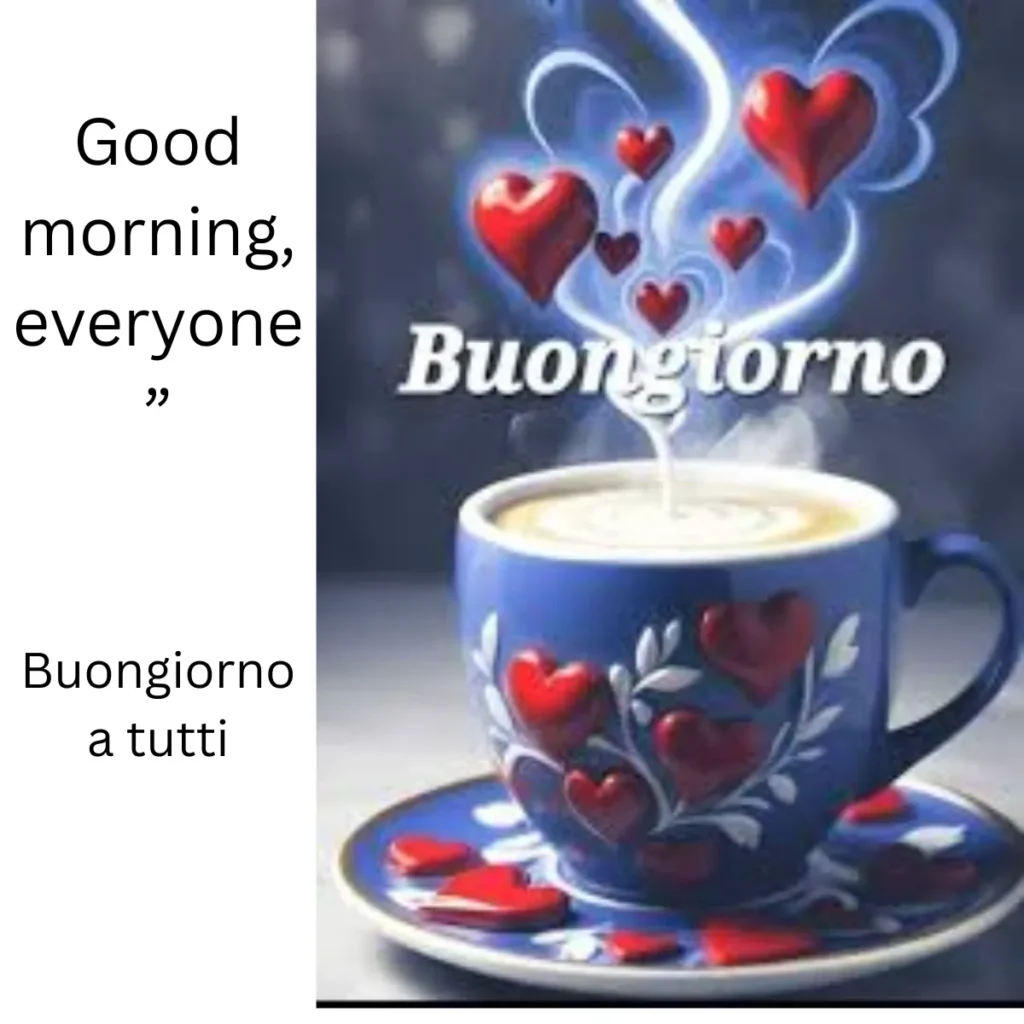
Origin:
A polite and inclusive greeting meaning “Good morning, everyone.”
Example:
👤 User A: Buongiorno a tutti!
👤 Group: Buongiorno!
Use: Group settings, meetings, classrooms.
Hello in Italy
🔹 Origin
In Italy, the most common way to say hello is “Ciao”, which originated from the Venetian phrase s’ciavo vostro, meaning “I am your servant.” Over time, it evolved into a friendly greeting used both for hello and goodbye. Italians also use greetings like salve, buongiorno, and buonasera, depending on the formality and time of day.
🔹 Examples
- Ciao, come stai? → Hello, how are you?
- Salve, piacere di conoscerla. → Hello, nice to meet you.
- Buongiorno, signora. → Good morning, madam.
- Buonasera a tutti! → Good evening, everyone!
- Ciao ragazzi! → Hello, guys!
13. Come va?
Origin:
Means “How’s it going?” While technically a question, it’s often used as a greeting.
Example:
👤 User A: Ciao! Come va?
👤 User B: Va bene, grazie! E tu?
Use: Informal, conversational.
14. Tutto bene?
Origin:
Literally, “Everything good?” Used often as a casual way to check in when saying hi.
Example:
👤 User A: Ciao! Tutto bene?
👤 User B: Sì, tutto bene! Tu?
Use: Informal; caring tone.
15. Benvenuto / Benvenuta
Origin:
Means “Welcome” (masculine/feminine). Common when greeting someone into a home, event, or community.
Example:
👤 User A: Benvenuto in Italia!
👤 User B: Grazie! È bellissima!
Use: Warm and formal; perfect for arrivals or first meetings.
FAQs
1. What is the most common way to say “hello” in Italian?
The most common word is “Ciao”, used with friends and people you know.
2. How do you say hello politely in Italian?
Use “Salve” or “Buongiorno” (good morning/day).
3. Can I use “Ciao” with everyone?
Not always — Ciao is informal. Use Salve or Buongiorno in formal situations.
4. How do you say “hello” in the evening?
Say “Buonasera” (good evening).
5. What about saying hello on the phone?
Say “Pronto” when answering a call.
6. How do you greet a group politely?
Say “Salve a tutti” (hello everyone).
7. Is “Ciao” also used for goodbye?
Yes! Ciao can mean both hello and goodbye depending on the context.
8. What is a friendly morning greeting?
“Buongiorno!” said with a smile is perfect.
9. How do you say “Hi guys!” in Italian?
Say “Ciao ragazzi!” (casual).
10. How do I greet respectfully in a business setting?
Use “Buongiorno” (daytime) or “Buonasera” (evening), avoid Ciao.
Conclusion:
Now that you know how to say hello in Italian, you can greet people confidently and make a warm first impression.If you’re speaking in a formal setting, chatting with friends, or meeting new people, this simple phrase can open the door to meaningful conversations.
Keep practicing how to say hi in Italian so it becomes natural and effortless. A friendly greeting in Italian not only shows respect for the culture but also helps you connect on a more personal level.
